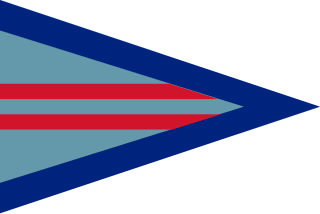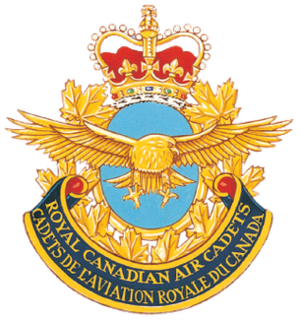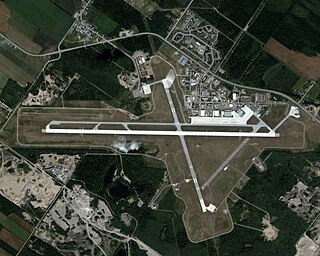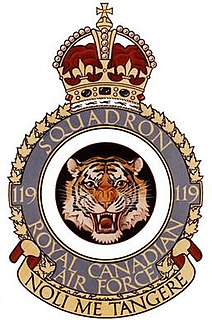
The Canadian Armed Forces (CAF) are the unified armed forces of Canada.

The Snowbirds, officially known as 431 Air Demonstration Squadron, are the military aerobatics or air show flight demonstration team of the Royal Canadian Air Force. The team is based at 15 Wing Moose Jaw near Moose Jaw, Saskatchewan. The Snowbirds' official purpose is to "demonstrate the skill, professionalism, and teamwork of Canadian Forces personnel". The Snowbirds are the first Canadian air demonstration team to be designated as a squadron.
The history of the Royal Canadian Air Force begins in 1920, when the air force was created as the Canadian Air Force (CAF). In 1924 the CAF was renamed the Royal Canadian Air Force (RCAF) when it was granted the royal title by King George V. The RCAF existed as an independent service until 1968. Prior attempts at forming an air force for Canada were the Canadian Aviation Corps that was attached to the Canadian Expeditionary Force, and a two-squadron Canadian Air Force that was attached to the Royal Air Force.

Wing commander is a senior commissioned rank in the British Royal Air Force and air forces of many countries which have historical British influence, including many Commonwealth countries but not including Canada and South Africa. It is sometimes used as the English translation of an equivalent rank in countries which have a non-English air force-specific rank structure. It ranks immediately above squadron leader and immediately below group captain.
In military aviation, a wing is a unit of command. In most military aviation services, a wing is a relatively large formation of planes. In Commonwealth countries a wing usually comprises three squadrons, with several wings forming a group. Each squadron will contain around 20 planes.

The Royal Canadian Air Cadets is a Canadian national youth program for young individuals aged 12 to 19. Under the authority of the National Defence Act, the program is administered by the Canadian Forces (CF) and funded through the Department of National Defence (DND). Additional support is provided by the civilian Air Cadet League of Canada (ACL). Together with the Royal Canadian Sea Cadets and Royal Canadian Army Cadets, it forms the "largest federally funded youth program in the country". Cadets are not members of the military and are not obliged to join the Canadian Forces.

The Royal Canadian Air Force is the air force of Canada. Its role is to "provide the Canadian Forces with relevant, responsive and effective airpower". The RCAF is one of three environmental commands within the unified Canadian Armed Forces. As of 2013, the Royal Canadian Air Force consists of 14,500 Regular Force and 2,600 Primary Reserve personnel, supported by 2,500 civilians, and operates 258 manned aircraft and 9 unmanned aerial vehicles. Lieutenant-General Al Meinzinger is the current commander of the Royal Canadian Air Force and chief of the Air Force Staff.

Canadian Forces Base Trenton, formerly RCAF Station Trenton, is a Canadian Forces base located within the city of Quinte West, Ontario. It is operated as an air force base by the Royal Canadian Air Force (RCAF) and is the hub for air transport operations in Canada and abroad. Its primary RCAF lodger unit is 8 Wing, commonly referred to as 8 Wing Trenton. CFB Trenton is Canada's largest Air Force base.

Canadian Forces Base Bagotville, commonly referred to as CFB Bagotville, and also known as Bagotville Airport or Saguenay-Bagotville Airport, is a Canadian Forces base located 4.5 nautical miles west of Bagotville in the city of Saguenay. Located in the centre of Quebec, less than 200 km (120 mi) north of Quebec City, CFB Bagotville is operated as an air force base by the Royal Canadian Air Force (RCAF) and is one of two bases in the country using the CF-18 Hornet fighter/interceptor, the other being CFB Cold Lake. Its primary RCAF lodger unit is 3 Wing, commonly referred to as 3 Wing Bagotville.

The Primary Reserve of the Canadian Armed Forces is the first and largest of the four sub-components of the Canadian Forces reserves, followed by the Supplementary Reserve, the Canadian Rangers, and the Cadet Organizations Administration and Training Service.

Air Commodore Arthur Dwight Ross was a Royal Canadian Air Force (RCAF) Base Commander of No. 62 Base, No. 6 Group RCAF in Yorkshire, England during the Second World War. Ross received the George Cross for his actions on the night of 27/28 June 1944 at RAF Tholthorpe.

The Civil Air Patrol (CAP) is a congressionally chartered, federally supported non-profit corporation that serves as the official civilian auxiliary of the United States Air Force (USAF). CAP is a volunteer organization with an aviation-minded membership that includes people from all backgrounds, lifestyles, and occupations. It performs three congressionally assigned key missions: emergency services, which includes search and rescue and disaster relief operations; aerospace education for youth and the general public; and cadet programs for teenage youth. In addition, CAP has recently been tasked with homeland security and courier service missions. CAP also performs non-auxiliary missions for various governmental and private agencies, such as local law enforcement and the American Red Cross. The program is established as an organization by Title 10 of the United States Code and its purposes defined by Title 36.

426 Transport Training Squadron is a unit of the Canadian Forces under Royal Canadian Air Force, located at CFB Trenton in Trenton, Ontario. It originated as a squadron in the Royal Canadian Air Force (RCAF) that fought during the Second World War as a bomber squadron.

Air Marshal George Owen Johnson CB, MC was a Canadian aviator, World War I Flying Ace and a senior commander in the Royal Canadian Air Force during World War II.

The Canadian Cadet Organizations, marketed under the name of Cadets Canada, are a youth program known as the Royal Canadian Sea Cadets, Royal Canadian Army Cadets, and Royal Canadian Air Cadets. The program is sponsored by the Canadian Armed Forces and funded through the Department of National Defence (DND), with support from civilian groups, namely the Navy League, the Army Cadet League and the Air Cadet League, as well as local community sponsors that include service organizations and parents of cadets.

No. 119 Squadron was an RCAF Canadian Home War Establishment (HWE) Squadron. Created 15 May 1935 in Hamilton, Ontario, it came to be tasked with coastal patrol and anti-submarine duty over the Gulf of St. Lawrence and the Atlantic Ocean around Nova Scotia. It was disbanded 15 March 1944 in Sydney, Nova Scotia.
Air Vice-Marshal Francis Scholes ‘Frank’ McGill, CB was a prominent member of Canada's military, having been an air vice marshal in the RCAF, and a considerable sports figure, amongst other things a star football player in the Canadian Football League for the Montreal AAA Winged Wheelers.
The Canadian Air Force (CAF), which was formed on 17 May 1920, was one of Canada's early attempts at forming an air force. When the Air Board was formed in 1919 to manage Canadian aviation, one of its responsibilities was air defence; the CAF was formed to meet this responsibility. The CAF would exist until 1924 when the prefix "Royal" was added, and the Royal Canadian Air Force (RCAF) was officially created.

Air Marshal Harold "Gus" Edwards, was a Canadian Air Force officer who played a prominent role in building the Royal Canadian Air Force (RCAF). From November 1941 to December 1943, Edwards served as Air Officer Commanding-in-Chief Overseas where he was responsible for all RCAF personnel. In June 2012, Edwards was posthumously inducted into Canada's Aviation Hall of Fame for his "outstanding leadership in building Canada's national air force".















